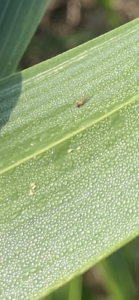Grain sorghum across Refugio, Calhoun and Victoria Counties ranges from 4-5 leaf to bloom. The two primary insects of concern this week for grain sorghum in the Mid-Coast of Texas are Sorghum Midge and Sugarcane Aphids.
The Sugarcane Aphid can be found in Johnsongrass adjacent to sorghum fields, so the aphids may jump into the sorghum soon. Begin inspecting field margins and areas of the field with Johnsongrass present.
Fields beginning to bloom should be inspected for Sorghum Midge. Begin scouting for midge soon after head emergence when yellow blooms first appear in the field. Scout for sorghum midge at mid-morning when the temperature warms to approximately 85 degrees F. The adult lives for only a day, and each day a new brood of adults emerges. For this reason, flowering fields should be sampled almost daily.
Sorghum midge can be monitored by inspecting carefully and at close range all sides of randomly selected flowering grain heads. Look for the reddish, gnat-like adults crawling on or flying about flowering heads. Handle grain heads carefully during inspection to avoid disturbing adult sorghum midges. Another sampling method is to gently but quickly slip a one-gallon clear plastic bag over the head and tap the head to disturb midge which will fly up in the bag where they can be easily seen and counted. A more rapid yet still efficient method is to turn the head downward into a white plastic bucket or pail and beat the head in the bucket to knock the midge from the head. Remove the head and count any sorghum midge in the pail or bucket. A one-gallon milk jug with the bottom cut out also works well for this type of sampling.
Because they are relatively weak fliers and rely on wind currents to aid their dispersal, adult sorghum midges usually are most abundant along edges of sorghum fields. For this reason, inspect plants along field borders first, particularly those downwind of earlier flowering sorghum or Johnsongrass. If no or few sorghum midges are found on sorghum grain heads along field edges, there should be little need to sample the entire field.
However, if you find more than one sorghum midge per flowering grain head in border areas of a sorghum field, inspect the rest of the field. Sample at least 20 flowering grain heads for every 20 acres in a field. For fields smaller than 20 acres, sample 40 flowering grain heads.
Calculate the economic injury level for sorghum midge using the following equation:
Number of sorghum midges/flowering heads = Cost of control as $A × 33256 / Value of grain as $ per cwt × Number of flowering heads per acre
| Table 17. Estimated economic injury levels for sorghum midge for a range of factors. (This table is only a guide. Use the equation in the text to estimate the economic injury level in your field.) | ||||
|
Economic injury level—mean number of midges/flowering head |
||||
|
Control cost, $/A |
Crop value, $100 lb |
Flowering heads = 18,000/A |
Flowering heads = 45,000/A |
Flowering heads = 67,500/A |
|
5 |
6 |
1.6 |
0.6 |
0.4 |
|
5 |
7 |
1.3 |
0.5 |
0.34 |
|
5 |
8 |
1.2 |
0.5 |
0.3 |
|
6 |
6 |
1.9 |
0.8 |
0.5 |
|
6 |
7 |
1.6 |
0.7 |
0.4 |
|
6 |
8 |
1.4 |
0.6 |
0.35 |
|
7 |
6 |
2.2 |
0.85 |
0.6 |
|
7 |
7 |
1.9 |
0.75 |
0.5 |
|
7 |
8 |
1.6 |
0.65 |
0.45 |
A key principal to remember is properly timed applications of insecticides, herbicides and fungicides prevent yield loss, they do not increase yield. With this in mind, it is still critical to control pests when the yield potential is lower to prevent additional profit loss from pests.



